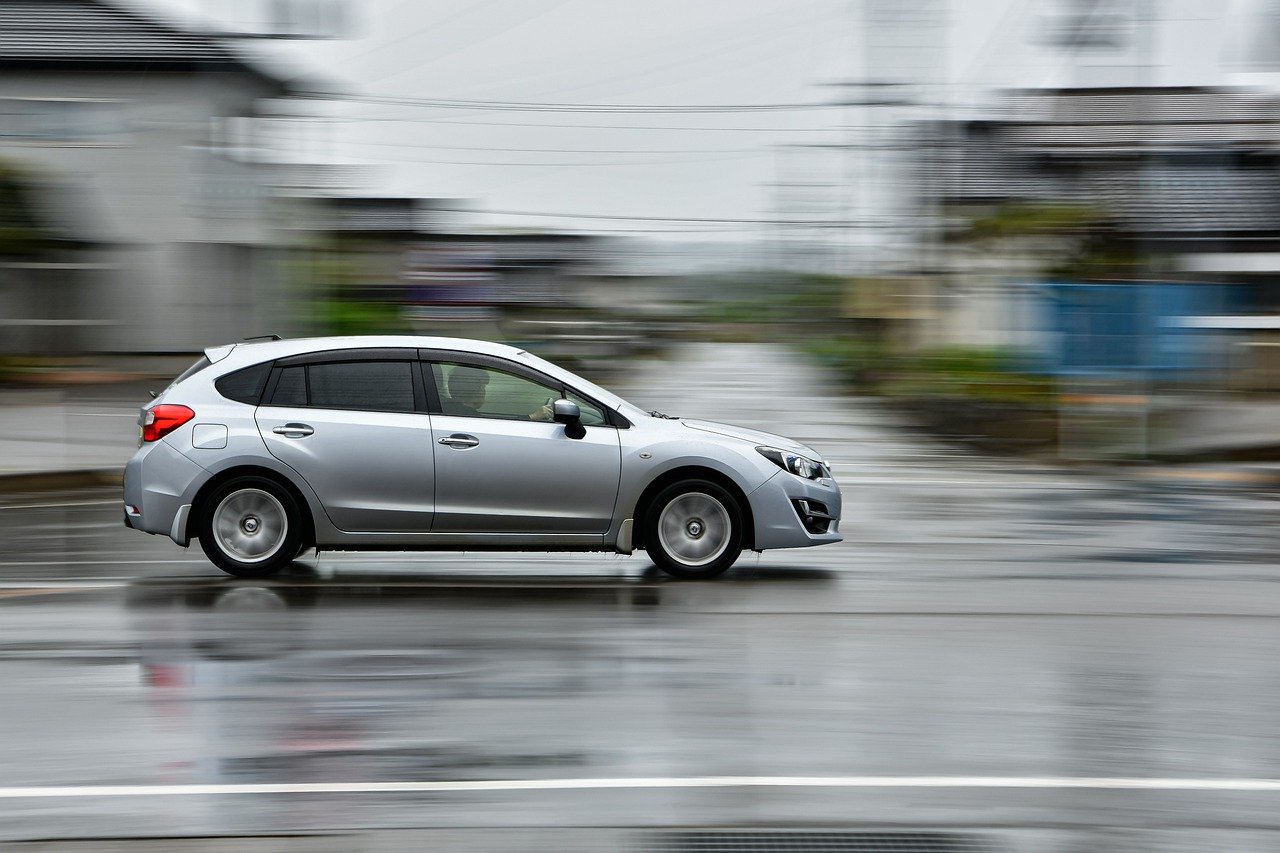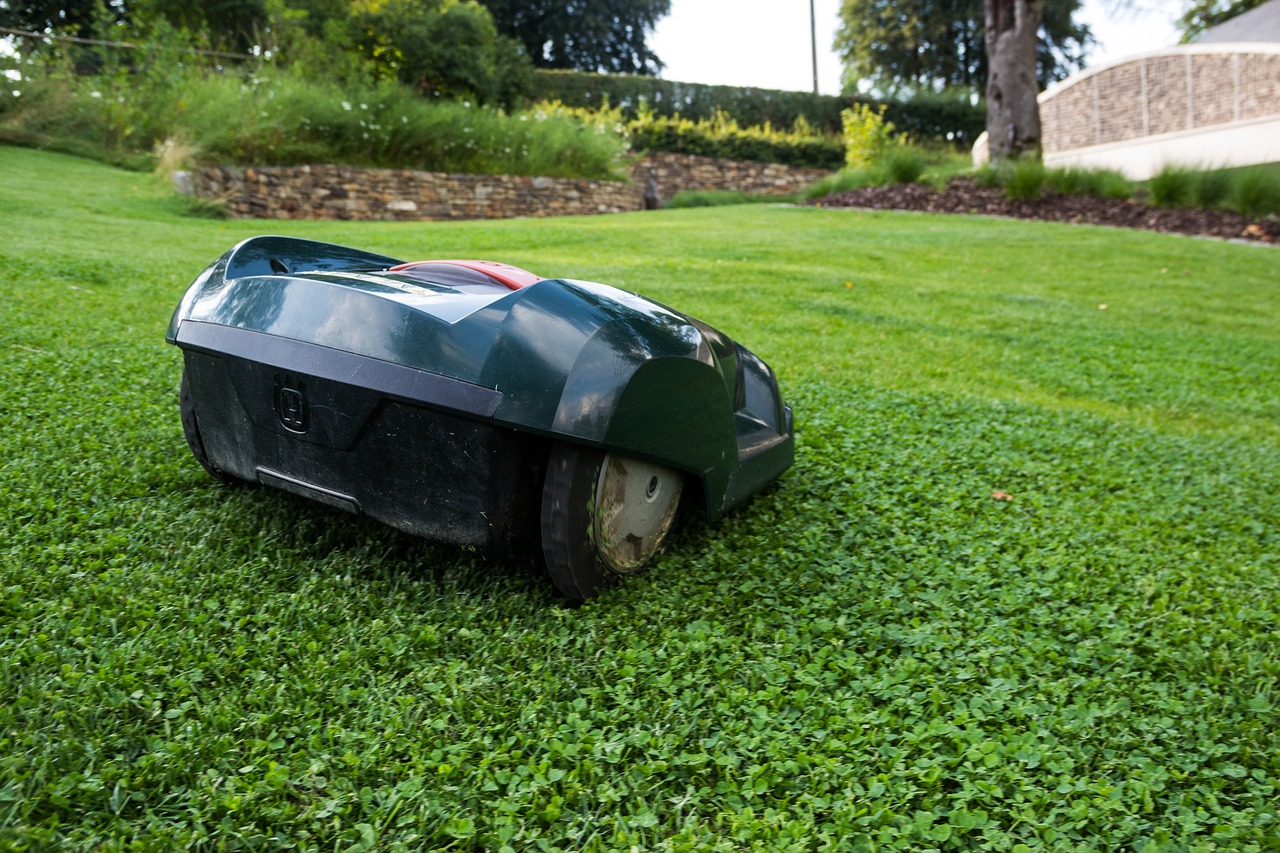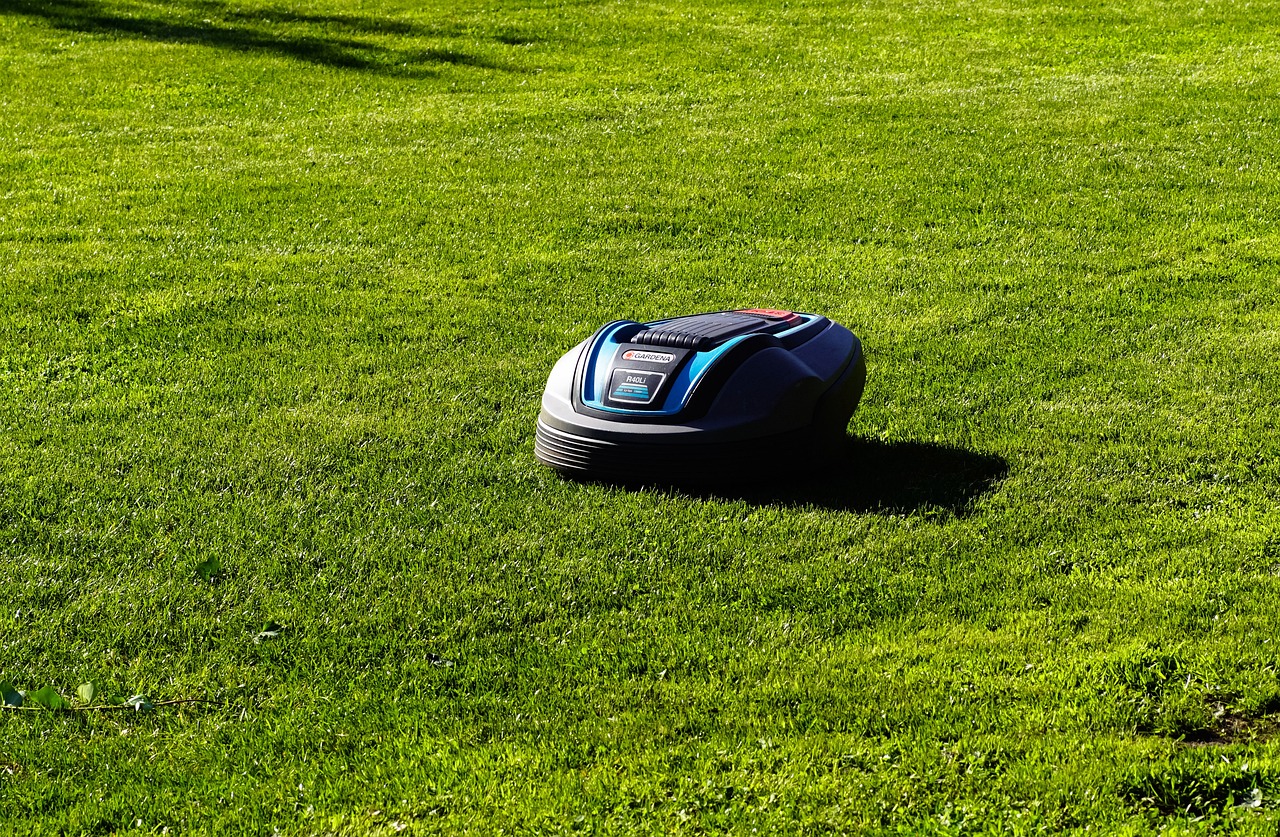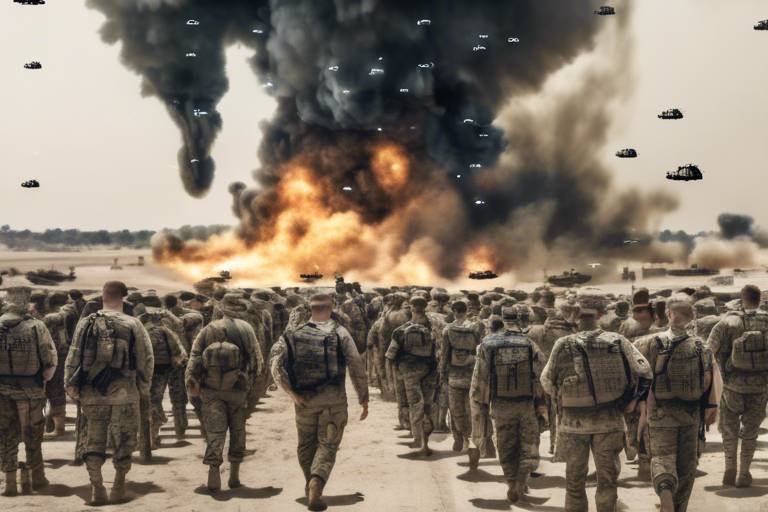Robotic Ground Vehicles - Future of Unmanned Warfare
The landscape of modern warfare is undergoing a dramatic transformation, and at the heart of this evolution are robotic ground vehicles. These unmanned machines are not just a technological marvel; they represent a fundamental shift in how military operations are conducted. Imagine a battlefield where soldiers are supported by intelligent robots that can navigate hostile terrain, gather critical intelligence, and even engage in combat—all while keeping human lives out of harm's way. This isn't science fiction; it’s the reality of today’s military strategies.
As we delve into the world of robotic ground vehicles, it’s essential to understand their evolution. From rudimentary remote-controlled units to sophisticated autonomous systems equipped with artificial intelligence, these vehicles are designed to perform a variety of roles. They enhance operational effectiveness, improve safety for personnel, and streamline logistics on the battlefield. With their ability to operate in environments that are too dangerous for humans, these robots are becoming indispensable assets in military operations.
Robotic ground vehicles are not just about replacing soldiers; they are about augmenting human capabilities. They can be deployed in various scenarios, whether it's for reconnaissance, combat, or logistical support. By leveraging advanced technologies such as machine learning, sensors, and real-time data processing, these vehicles can make decisions and execute tasks faster than any human could. This capability is crucial in combat situations where every second counts.
Moreover, the integration of robotic ground vehicles into military strategies presents a unique opportunity for nations to rethink their approach to warfare. Countries that invest in these technologies are not only enhancing their military prowess but are also setting the stage for future conflicts where robotic systems play a central role. The implications of this shift are vast, influencing everything from tactical planning to international relations.
In summary, the future of unmanned warfare is bright, with robotic ground vehicles leading the way. As these technologies continue to advance, we can expect to see even more innovative applications that will redefine the battlefield. However, with great power comes great responsibility. The ethical considerations surrounding the use of these machines will need to be addressed to ensure that they are used in a manner that aligns with international laws and moral standards.
- What are robotic ground vehicles?
Robotic ground vehicles are unmanned systems designed to operate on land, performing tasks such as surveillance, reconnaissance, and combat, often equipped with artificial intelligence.
- How do robotic vehicles enhance military operations?
They increase efficiency, reduce risk to personnel, and can operate in environments that are too dangerous for human soldiers.
- What are the ethical concerns regarding robotic warfare?
Key concerns include accountability for actions taken by autonomous systems, the potential for misuse, and the implications of reducing human oversight in combat situations.
- Will robotic ground vehicles replace human soldiers?
While they will augment military capabilities, they are not intended to fully replace human soldiers but rather to work alongside them to enhance effectiveness and safety.

Technological Advancements in Robotics
The realm of robotics has undergone a remarkable transformation in recent years, primarily driven by groundbreaking advancements in artificial intelligence (AI) and machine learning. These technologies have not only enhanced the capabilities of robotic ground vehicles but have also redefined their roles in modern warfare. Imagine a battlefield where machines can independently assess situations, make decisions, and execute tasks with minimal human intervention. This is no longer a distant fantasy; it is becoming a reality.
One of the most significant advancements is the development of autonomous navigation systems. These systems allow robotic ground vehicles to traverse complex terrains without human guidance. By utilizing a combination of GPS, LIDAR, and computer vision, these vehicles can identify obstacles, plan routes, and adapt to changing environments in real-time. This level of autonomy not only enhances operational efficiency but also significantly reduces the risk to human soldiers who would otherwise have to navigate these hazardous areas.
Furthermore, the integration of advanced sensors and cameras has revolutionized reconnaissance capabilities. Modern robotic vehicles are equipped with high-resolution imaging systems that can capture detailed visuals and gather critical data from the battlefield. This real-time intelligence is crucial for mission planning and threat assessment, enabling military strategists to make informed decisions based on accurate information. For instance, a reconnaissance robot can scout enemy positions and relay vital information back to command centers, allowing for strategic planning without putting personnel in harm's way.
However, these advancements come with their own set of challenges. The sheer volume of data generated by these sophisticated systems can lead to information overload. Military operators must sift through vast amounts of data to extract actionable insights, which can be time-consuming and overwhelming. Additionally, environmental factors such as weather conditions and terrain can affect sensor performance, necessitating ongoing research and development to enhance reliability.
In summary, the technological advancements in robotics are not just enhancing the capabilities of unmanned ground vehicles; they are fundamentally changing the landscape of warfare. With autonomous navigation, advanced sensors, and real-time data processing, these vehicles are poised to play a pivotal role in future military operations. The question remains: how will military strategies evolve to fully leverage these remarkable technologies?
- What are robotic ground vehicles?
Robotic ground vehicles are unmanned systems designed for various military applications, including reconnaissance, combat, and logistics. - How do technological advancements impact military operations?
Advancements in robotics enhance efficiency, reduce risks to personnel, and provide real-time intelligence, thereby improving overall operational effectiveness. - What challenges do robotic ground vehicles face?
Challenges include data overload, sensor limitations, and the need for ongoing research to improve reliability in diverse environments.

Types of Robotic Ground Vehicles
The landscape of modern warfare is rapidly changing, and at the forefront of this evolution are robotic ground vehicles. These innovative machines come in various shapes and sizes, each tailored to fulfill specific roles on the battlefield. From reconnaissance to direct combat, these vehicles enhance operational effectiveness and ensure the safety of military personnel. Imagine a battlefield where soldiers can rely on machines to gather intelligence, engage enemies, or deliver supplies without putting their lives at risk. This is the reality that robotic ground vehicles are creating.
Robotic ground vehicles can be broadly categorized into three main types: reconnaissance drones, combat robots, and supply vehicles. Each type plays a crucial role in modern military operations:
- Reconnaissance Drones: These unmanned vehicles are equipped with state-of-the-art sensors and cameras, enabling them to gather real-time data and conduct surveillance missions. They are essential for intelligence gathering, allowing commanders to assess threats without exposing soldiers to danger.
- Combat Robots: Designed for direct engagement, combat robots are armed with advanced weaponry and tactical capabilities. They can change the dynamics of ground warfare by taking on enemy forces, thus reducing the risk of human casualties.
- Supply Vehicles: These vehicles are responsible for transporting essential supplies and equipment to troops in the field. By automating logistics, they ensure that soldiers receive the necessary resources without the risk associated with traditional supply routes.
Each of these robotic vehicles is engineered with specific technologies and functionalities that enhance their effectiveness in combat scenarios. For instance, reconnaissance drones often utilize high-resolution cameras and thermal imaging to operate effectively in various environments. On the other hand, combat robots may feature advanced targeting systems, allowing them to engage enemies with precision. Supply vehicles often incorporate automated navigation systems, which enable them to transport goods efficiently while avoiding hazards.
As we delve deeper into the capabilities of these robotic ground vehicles, it’s essential to acknowledge the profound impact they have on military strategies and operations. With their ability to operate in hostile environments, these vehicles not only enhance the effectiveness of military missions but also contribute to the overall safety of military personnel. The integration of such technology into military operations signifies a shift towards a more automated and efficient approach to warfare, where human soldiers can focus on strategic decision-making rather than engaging directly in combat.
In summary, the types of robotic ground vehicles are not just tools of war; they are pivotal elements that redefine how military operations are conducted. As technology continues to advance, we can expect to see even more sophisticated systems that will further enhance the capabilities of armed forces around the globe.
- What are robotic ground vehicles? Robotic ground vehicles are unmanned machines designed to perform various tasks on the battlefield, including reconnaissance, combat, and supply transport.
- How do reconnaissance drones work? They utilize advanced sensors and cameras to gather real-time data and conduct surveillance, helping military commanders assess threats without risking human lives.
- What are the benefits of using combat robots? Combat robots can engage enemy forces directly, reducing the risk of human casualties and changing the dynamics of ground warfare.
- Are there any ethical concerns associated with robotic ground vehicles? Yes, the rise of these technologies raises significant ethical questions regarding accountability and decision-making in combat scenarios.

Reconnaissance and Surveillance Robots
In the rapidly evolving landscape of modern warfare, have emerged as vital assets on the battlefield. These unmanned vehicles are not just mechanical tools; they are sophisticated systems equipped with advanced sensors, cameras, and communication technology that enable them to gather real-time intelligence in hostile environments. Imagine having a set of eyes that can fly over enemy territory, capturing crucial data without putting a soldier's life at risk. This is the reality that reconnaissance robots bring to military operations.
What sets these robots apart is their ability to operate autonomously or under human guidance, providing flexibility in various combat scenarios. They can traverse challenging terrains, from rugged mountains to dense urban environments, while collecting vital information about enemy positions, movements, and potential threats. The integration of artificial intelligence allows these robots to analyze data on the fly, delivering insights that can significantly enhance mission planning and execution.
Furthermore, reconnaissance robots play a crucial role in real-time data collection. Equipped with high-resolution cameras and various sensors, they can detect changes in the battlefield landscape, monitor troop movements, and even identify potential ambushes. This capability not only aids in immediate tactical decisions but also contributes to long-term strategic planning. By providing commanders with accurate and timely information, these robots help in assessing threats and making informed decisions, ultimately saving lives and resources.
However, the deployment of reconnaissance robots is not without its challenges. One major concern is data overload. With the vast amounts of information these systems can generate, military analysts must sift through and prioritize data to extract actionable intelligence. Additionally, environmental factors such as weather conditions and terrain can affect sensor performance, leading to potential gaps in information. Therefore, ongoing research and development are essential to enhance the efficiency and reliability of these surveillance technologies.
In conclusion, reconnaissance and surveillance robots represent a significant advancement in military technology. They not only minimize risks to human soldiers but also provide a level of operational effectiveness that was previously unattainable. As these technologies continue to evolve, they will undoubtedly play an even more critical role in shaping the future of warfare.
- What are reconnaissance and surveillance robots?
These are unmanned vehicles designed to gather intelligence and monitor enemy activities without putting soldiers at risk. - How do these robots collect data?
They are equipped with advanced sensors and cameras that allow them to capture real-time information and analyze it using artificial intelligence. - What challenges do reconnaissance robots face?
Data overload, sensor limitations, and environmental factors can hinder their effectiveness, necessitating ongoing improvements in technology. - Are there ethical concerns regarding their use?
Yes, the deployment of these robots raises questions about accountability and decision-making in combat scenarios.

Benefits of Reconnaissance Robots
Reconnaissance robots have become a game changer on the battlefield, offering a plethora of benefits that enhance military operations. One of the most significant advantages of these unmanned vehicles is their ability to minimize risks to human soldiers. Imagine sending a robot into a hostile area instead of a soldier; this not only protects lives but also allows for more daring reconnaissance missions in environments that would be too dangerous for personnel. This capability is crucial, especially when assessing enemy positions or gathering intelligence in unpredictable situations.
Furthermore, reconnaissance robots are equipped with advanced sensors and cameras that provide real-time data collection. This means military strategists can receive immediate feedback on the battlefield conditions, allowing for swift decision-making. For instance, if a reconnaissance robot detects enemy movement, commanders can quickly adjust their tactics, ensuring they stay one step ahead. The efficiency of these robots in gathering information leads to more informed tactical decisions, which can significantly influence the outcome of military engagements.
Another notable benefit is the cost-effectiveness of using robotic systems. While the initial investment in technology may be high, the long-term savings are substantial. By reducing the number of personnel needed in dangerous areas, the military can save on training, equipment, and healthcare costs associated with injuries. Moreover, fewer human soldiers in the field mean less psychological strain on troops, allowing them to focus on their missions without the constant fear of danger.
Reconnaissance robots also provide enhanced operational capabilities. They can operate in environments that are challenging for humans, such as extreme weather conditions or hazardous terrains. This adaptability not only increases the range of missions that can be undertaken but also improves the quality of intelligence gathered. For example, robots can traverse rough landscapes or navigate through dense forests, capturing data that would be nearly impossible for a human team to collect safely.
In summary, the benefits of reconnaissance robots are profound. They offer a blend of safety, efficiency, and cost-effectiveness, transforming how military operations are conducted. As technology continues to advance, we can expect these unmanned systems to play an even more critical role in shaping the future of warfare.
- What are reconnaissance robots used for?
Reconnaissance robots are primarily used for gathering intelligence, assessing enemy positions, and collecting data in hostile environments without putting human lives at risk. - How do reconnaissance robots enhance safety for soldiers?
By deploying robots in dangerous areas, military forces can reduce the exposure of human soldiers to potential threats, thereby enhancing their safety during operations. - Are reconnaissance robots cost-effective?
Yes, although the initial investment may be high, the long-term savings from reduced personnel costs and fewer injuries can make them a cost-effective solution for military operations. - What technologies do reconnaissance robots use?
These robots utilize advanced sensors, cameras, and artificial intelligence to collect and analyze data in real-time, providing crucial intelligence for military strategies.

Challenges in Surveillance Technology
While the advancements in surveillance technology for robotic ground vehicles are impressive, they are not without their challenges. One of the most significant hurdles is data overload. Modern surveillance robots can collect vast amounts of information in real-time, from high-definition video feeds to detailed sensor data. However, processing this data can become overwhelming, leading to critical information being lost in a flood of irrelevant data. Imagine trying to find a needle in a haystack—this is akin to the challenge faced by military analysts who must sift through terabytes of data to extract actionable intelligence.
Another challenge lies in the limitations of sensors. While technology has progressed, sensors can still struggle in adverse conditions such as poor weather, low visibility, or electronic warfare tactics employed by adversaries. For instance, fog or heavy rain can significantly impair a robot's ability to gather clear images, which is vital for accurate reconnaissance. Additionally, the effectiveness of sensors can be compromised by environmental factors, making it crucial for developers to continuously innovate and enhance these technologies.
Moreover, the integration of new technologies can introduce compatibility issues. As robotic systems become more sophisticated, ensuring that all components—sensors, communication systems, and data processing units—work seamlessly together becomes a complex task. If these systems cannot communicate effectively, the entire operation could be jeopardized, leading to missed opportunities for intelligence gathering or even operational failures.
Lastly, there is the issue of cybersecurity. As surveillance robots become more connected and reliant on data networks, they become potential targets for cyber attacks. Adversaries could exploit vulnerabilities in these systems to disrupt operations or manipulate data, leading to catastrophic consequences on the battlefield. This highlights the necessity for robust cybersecurity measures to protect these advanced technologies from being hijacked or sabotaged.
In summary, while the capabilities of robotic surveillance technology are advancing rapidly, the challenges of data overload, sensor limitations, integration issues, and cybersecurity must be addressed to fully realize their potential on the battlefield. Continuous research and innovation are essential to overcome these obstacles and ensure that these robotic systems can operate effectively in the complex and dynamic environments of modern warfare.
- What are the main challenges faced by robotic surveillance technology?
The main challenges include data overload, sensor limitations, integration issues, and cybersecurity threats.
- How does data overload affect military operations?
Data overload can lead to critical information being overlooked, making it difficult for analysts to extract actionable intelligence from the collected data.
- Why are sensor limitations a concern for surveillance robots?
Sensor limitations can impair the robot's ability to gather clear images and data, especially in adverse weather conditions, which is crucial for effective reconnaissance.
- What role does cybersecurity play in robotic warfare?
Cybersecurity is vital to protect robotic systems from being hacked or manipulated, which could disrupt operations and lead to significant consequences.

Combat Robots and Their Role
In the ever-evolving landscape of warfare, combat robots have emerged as a game-changing element, fundamentally altering how military operations are conducted. These unmanned systems are designed not just to assist but to actively engage enemy forces, showcasing advanced weaponry and tactical capabilities. Imagine a battlefield where machines take the forefront, equipped with precision targeting systems and the ability to analyze threats in real-time. This shift not only enhances operational effectiveness but also significantly reduces the risk to human soldiers.
Combat robots come in various forms, from ground-based units to aerial support systems, each tailored to fulfill specific roles. For instance, ground combat robots can be deployed for direct engagement, reconnaissance, or even logistical support. Their advanced sensors and artificial intelligence allow them to navigate complex terrains and make split-second decisions that can mean the difference between mission success and failure. The integration of these technologies brings about a new era of warfare, where human oversight and robotic efficiency work hand in hand.
One of the most significant advantages of combat robots is their ability to operate in environments that would be too dangerous for human soldiers. They can traverse hostile terrains, withstand harsh weather conditions, and engage in combat scenarios that would otherwise be deemed too risky. This capability not only preserves human life but also allows for a more aggressive and strategic approach to warfare. By using robots, military forces can maintain a tactical advantage, striking swiftly and effectively while minimizing casualties.
However, the deployment of combat robots is not without its challenges. The ethical implications of using machines in warfare raise serious questions. For instance, who is accountable if a robot makes a fatal mistake? As these machines gain more autonomy, the need for clear guidelines and oversight becomes crucial. The potential for autonomous systems to engage in lethal actions without human intervention poses significant risks, and addressing these concerns is essential for the responsible use of combat robots.
In addition to ethical considerations, the integration of combat robots into military strategies requires comprehensive training and operational protocols. Soldiers must learn to work alongside these machines, understanding their capabilities and limitations. The collaboration between humans and robots can lead to enhanced outcomes, but it also necessitates a shift in traditional military training programs. As the technology advances, so too must the strategies that govern its use.
The future of combat robots in warfare is bright yet complex. As technology continues to develop, we can expect even more sophisticated systems that can operate autonomously or in tandem with human forces. This evolution will undoubtedly influence military strategies, tactics, and the overall nature of conflict itself. The question remains: will we embrace this technological leap, or will we tread carefully, mindful of the implications it brings?
- What are combat robots?
Combat robots are unmanned systems designed to engage enemy forces directly, equipped with advanced weaponry and tactical capabilities. - How do combat robots enhance military operations?
They increase efficiency, reduce risk to human soldiers, and allow for operations in dangerous environments. - What are the ethical concerns surrounding combat robots?
Key concerns include accountability for actions taken by autonomous systems and the potential for unintended consequences in combat scenarios. - Will combat robots replace human soldiers?
While they may take on certain roles, the collaboration between humans and robots is likely to remain essential in military operations.

Advantages of Robotic Warfare
The integration of robotic ground vehicles into military operations is revolutionizing the way modern warfare is conducted. These unmanned systems offer a plethora of advantages that not only enhance operational efficiency but also significantly reduce risks to personnel. Imagine a battlefield where soldiers are no longer the first line of defense; instead, advanced robotic vehicles take on the brunt of the danger, allowing human operators to make strategic decisions from a safe distance. This shift is not just a technological marvel; it's a paradigm shift in how we approach conflict.
One of the most compelling benefits of robotic warfare is the increased efficiency it brings to military operations. Robotic ground vehicles can perform tasks with remarkable precision and speed, often surpassing human capabilities in high-pressure situations. For instance, when it comes to reconnaissance missions, these vehicles can cover vast terrains and gather critical data without putting any human lives at risk. This means that military planners can obtain real-time intelligence faster than ever before, allowing for better-informed tactical decisions.
Moreover, the cost-effectiveness of unmanned systems cannot be overlooked. While the initial investment in robotic technology may be substantial, the long-term savings are significant. By reducing the number of human soldiers deployed in high-risk missions, militaries can lower their operational costs and minimize equipment losses. A recent study indicated that deploying robotic ground vehicles could save up to 30% of the costs associated with traditional military operations over time. This financial efficiency is crucial for countries looking to maintain robust defense capabilities without overspending.
Another paramount advantage is the enhanced safety for troops. The deployment of unmanned systems allows military personnel to engage in combat scenarios without the direct exposure to danger. This not only protects lives but also reduces the psychological toll that warfare can have on soldiers. Imagine a soldier operating a sophisticated drone from a command center miles away, able to provide support without ever stepping foot on the battlefield. This level of safety can lead to improved morale and mental well-being among service members.
However, it's essential to recognize that while robotic warfare offers numerous benefits, it also presents challenges that require careful consideration. The reliance on technology introduces new vulnerabilities, such as susceptibility to hacking or technical malfunctions. As military strategies evolve, the balance between leveraging robotic systems and ensuring operational security will be crucial.
In summary, the advantages of robotic warfare are substantial and multifaceted. From increased efficiency and cost-effectiveness to enhanced safety for troops, these unmanned systems are poised to transform military operations. As we continue to explore the potential of robotic ground vehicles, it’s clear that the future of warfare will be shaped significantly by these technological advancements.
- What are robotic ground vehicles?
Robotic ground vehicles are unmanned systems designed for various military tasks, including reconnaissance, combat, and logistics support.
- How do robotic vehicles enhance safety for soldiers?
By taking on dangerous missions, robotic vehicles reduce the risk of injury or death for human soldiers, allowing them to operate from a safe distance.
- What are the cost implications of using robotic warfare?
While initial investments may be high, robotic systems can lead to long-term savings by decreasing the need for human soldiers and minimizing equipment losses.
- Are there ethical concerns related to robotic warfare?
Yes, the use of autonomous systems raises significant ethical questions regarding accountability and decision-making in combat situations.

Cost-Effectiveness of Unmanned Systems
This article explores the evolution and potential of robotic ground vehicles in modern warfare, focusing on their capabilities, advantages, and implications for military strategies and operations in the future.
Recent breakthroughs in artificial intelligence and robotics have significantly enhanced the capabilities of unmanned ground vehicles, enabling them to perform complex tasks autonomously and efficiently in various combat scenarios.
Robotic ground vehicles come in various forms, including reconnaissance drones, combat robots, and supply vehicles, each designed for specific roles on the battlefield, enhancing operational effectiveness and safety.
These unmanned vehicles are equipped with advanced sensors and cameras, allowing for real-time data collection and intelligence gathering, crucial for mission planning and threat assessment in hostile environments.
Utilizing reconnaissance robots minimizes risk to human soldiers while providing accurate and timely information, which is essential for making informed tactical decisions during operations.
Despite advancements, challenges such as data overload, sensor limitations, and environmental factors can hinder the effectiveness of surveillance robots, necessitating ongoing research and development.
Combat robots are designed to engage enemy forces directly, featuring advanced weaponry and tactical capabilities that can change the dynamics of ground warfare and reduce human casualties.
The integration of robotic ground vehicles into military operations offers numerous advantages, including increased efficiency, reduced risk to personnel, and enhanced operational capabilities in diverse combat situations.
Investing in robotic ground vehicles is not just a leap into the future of warfare; it’s also a strategic financial decision. The cost-effectiveness of unmanned systems manifests in various ways, making them an attractive option for military forces worldwide. First and foremost, these systems reduce the need for human soldiers on the front lines, which can significantly lower operational costs associated with training, salaries, and benefits. Imagine a scenario where a military unit can deploy a fleet of robots instead of sending dozens of soldiers into potentially lethal situations; the savings on personnel costs alone can be staggering.
Moreover, robotic ground vehicles can be engineered to withstand harsh environments and engage in high-risk missions, thus minimizing equipment losses. For instance, consider the following table that outlines the potential cost savings when utilizing robotic systems versus traditional methods:
| Aspect | Traditional Method | Robotic Systems |
|---|---|---|
| Personnel Costs | $1,000,000 (for 10 soldiers) | $200,000 (for 5 robots) |
| Training Expenses | $500,000 | $50,000 |
| Equipment Losses | $300,000 | $50,000 |
| Total Estimated Costs | $1,800,000 | $300,000 |
As shown in the table, the financial implications are clear: deploying robotic systems can lead to substantial savings. Additionally, these unmanned vehicles can operate continuously without the need for breaks, sleep, or food, further enhancing operational efficiency. This 24/7 capability allows for sustained operations in critical situations, providing a tactical advantage that human soldiers simply cannot match.
It's also worth mentioning that the maintenance costs for robotic systems tend to be lower compared to traditional military vehicles. With advancements in technology, many robotic systems are designed for easy repairs and upgrades, ensuring they remain effective over time without the extensive costs associated with human-operated machinery.
In conclusion, the cost-effectiveness of unmanned systems is a pivotal factor driving their integration into military operations. As nations strive to modernize their forces while managing budgets, embracing robotic ground vehicles is not just a trend; it’s a necessity for future warfare.
The rise of robotic ground vehicles raises significant ethical questions regarding accountability, decision-making in combat, and the potential for autonomous systems to engage in lethal actions without human intervention.
As robotic vehicles gain more autonomy, the challenge of ensuring ethical decision-making in combat scenarios becomes paramount, requiring clear guidelines and oversight to prevent unintended consequences.
The development of international regulations and treaties governing the use of robotic ground vehicles is essential to address the ethical implications and establish norms for their deployment in warfare.
Looking ahead, the evolution of robotic ground vehicles will likely continue to shape the landscape of military operations, influencing strategies, tactics, and the overall nature of warfare in the coming decades.
- What are robotic ground vehicles?
Robotic ground vehicles are unmanned systems designed for various military applications, including reconnaissance, combat, and supply missions.
- How do robotic vehicles enhance safety for soldiers?
By deploying unmanned systems, militaries can protect personnel from direct combat exposure, allowing for safer missions.
- What are the ethical concerns surrounding robotic warfare?
Concerns include accountability for actions taken by autonomous systems and the potential for unintended consequences in combat scenarios.

Enhanced Safety for Troops
This article explores the evolution and potential of robotic ground vehicles in modern warfare, focusing on their capabilities, advantages, and implications for military strategies and operations in the future.
Recent breakthroughs in artificial intelligence and robotics have significantly enhanced the capabilities of unmanned ground vehicles, enabling them to perform complex tasks autonomously and efficiently in various combat scenarios.
Robotic ground vehicles come in various forms, including reconnaissance drones, combat robots, and supply vehicles, each designed for specific roles on the battlefield, enhancing operational effectiveness and safety.
These unmanned vehicles are equipped with advanced sensors and cameras, allowing for real-time data collection and intelligence gathering, crucial for mission planning and threat assessment in hostile environments.
Utilizing reconnaissance robots minimizes risk to human soldiers while providing accurate and timely information, which is essential for making informed tactical decisions during operations.
Despite advancements, challenges such as data overload, sensor limitations, and environmental factors can hinder the effectiveness of surveillance robots, necessitating ongoing research and development.
Combat robots are designed to engage enemy forces directly, featuring advanced weaponry and tactical capabilities that can change the dynamics of ground warfare and reduce human casualties.
The integration of robotic ground vehicles into military operations offers numerous advantages, including increased efficiency, reduced risk to personnel, and enhanced operational capabilities in diverse combat situations.
Investing in robotic ground vehicles can lead to long-term savings by decreasing the need for human soldiers and minimizing equipment losses in high-risk missions.
One of the most compelling advantages of robotic ground vehicles is the enhanced safety they provide for military personnel. Traditional combat zones are fraught with danger, from enemy fire to improvised explosive devices (IEDs). By deploying unmanned systems, militaries can conduct operations with significantly reduced risk to human life. Imagine sending a robot into a hostile area to scout ahead, while soldiers remain safely behind cover. This not only preserves lives but also allows for more strategic planning during missions.
Moreover, robotic vehicles can be designed to withstand harsh conditions and perform tasks that would be too dangerous for human troops. For instance, in urban warfare, these robots can navigate through debris and hazardous environments, gathering intelligence without putting soldiers in harm's way. The ability to remotely control these vehicles means that troops can engage in combat scenarios from a distance, effectively managing threats while staying out of the line of fire.
Here are some specific ways robotic ground vehicles enhance troop safety:
- Risk Mitigation: Reducing direct exposure to combat situations.
- Intelligence Gathering: Collecting vital information without endangering personnel.
- Explosive Device Neutralization: Safely disarming IEDs and other threats.
In addition to physical safety, robotic ground vehicles also contribute to mental well-being. Warfare can take a toll on soldiers' mental health, and by minimizing their exposure to direct combat, these unmanned systems help reduce the psychological burden associated with traditional battlefield experiences. Ultimately, the deployment of robotic vehicles represents a significant shift towards safer military operations, making it possible for forces to engage effectively while prioritizing the safety of their troops.
The rise of robotic ground vehicles raises significant ethical questions regarding accountability, decision-making in combat, and the potential for autonomous systems to engage in lethal actions without human intervention.
As robotic vehicles gain more autonomy, the challenge of ensuring ethical decision-making in combat scenarios becomes paramount, requiring clear guidelines and oversight to prevent unintended consequences.
The development of international regulations and treaties governing the use of robotic ground vehicles is essential to address the ethical implications and establish norms for their deployment in warfare.
Looking ahead, the evolution of robotic ground vehicles will likely continue to shape the landscape of military operations, influencing strategies, tactics, and the overall nature of warfare in the coming decades.
- What are robotic ground vehicles?
Robotic ground vehicles are unmanned systems designed for various military applications, including reconnaissance, combat, and logistics. - How do robotic vehicles enhance troop safety?
They reduce direct exposure to combat situations, gather intelligence, and neutralize threats without putting soldiers in harm's way. - What are the ethical concerns surrounding robotic warfare?
Key concerns include accountability for actions taken by autonomous systems and the potential for unintended consequences in combat scenarios. - Will robotic ground vehicles replace human soldiers?
While they will enhance military operations, they are intended to complement human soldiers rather than completely replace them.

Ethical Considerations in Robotic Warfare
The rise of robotic ground vehicles in modern warfare brings with it a host of ethical considerations that cannot be ignored. As these machines become more autonomous and capable of making decisions on the battlefield, questions arise about accountability and the moral implications of their use. In a world where technology is advancing at lightning speed, how do we ensure that these robots act in accordance with our ethical standards?
One of the most pressing issues is the autonomy of robotic systems. As these vehicles are designed to operate with minimal human intervention, the challenge lies in programming them to make ethical decisions, especially in high-stakes combat situations. For instance, if a robotic vehicle encounters a target, will it be able to assess the situation accurately, considering factors like civilian presence and potential collateral damage? The prospect of machines making life-and-death decisions raises serious concerns about the moral responsibility of their actions.
Moreover, the potential for misuse of technology cannot be overlooked. With the ability to deploy combat robots comes the risk that they could be used inappropriately, leading to unnecessary violence and suffering. This brings us to the need for clear guidelines and regulations governing the deployment of robotic ground vehicles. Establishing a framework that outlines the acceptable use of these technologies is crucial for preventing their potential misuse.
Another important aspect is the psychological impact on soldiers and society at large. While robotic systems can reduce the risk to human personnel, they can also desensitize individuals to the realities of warfare. The distance created by operating machines from afar may lead to a lack of empathy for those affected by military actions. This phenomenon raises questions about the human experience of warfare and the potential erosion of moral values in combat scenarios.
Furthermore, the development of international regulations and treaties is essential to address these ethical implications. As nations continue to invest in robotic warfare, a global consensus on their use can help establish norms and standards that protect both combatants and civilians. Such treaties could cover aspects like:
- Accountability for actions taken by autonomous systems
- Guidelines for engagement rules
- Restrictions on the use of lethal force without human oversight
In conclusion, while robotic ground vehicles offer significant advantages in terms of operational efficiency and safety, their integration into warfare necessitates a careful examination of the ethical ramifications. As we move forward, it is imperative that we strike a balance between leveraging technology for military advantage and upholding our moral responsibilities. Only through ongoing dialogue, research, and international cooperation can we navigate the complex landscape of robotic warfare.
- What are robotic ground vehicles? - Robotic ground vehicles are unmanned machines designed for various military operations, including reconnaissance, combat, and logistics.
- How do ethical considerations affect the use of robotic warfare? - Ethical considerations focus on accountability, decision-making, and the potential for misuse, raising questions about the moral implications of using autonomous machines in combat.
- Are there international regulations governing robotic warfare? - Currently, there are ongoing discussions about establishing international regulations and treaties to address the ethical implications of robotic ground vehicles.
- What is the future of robotic ground vehicles in warfare? - The future of robotic ground vehicles is likely to see continued evolution, impacting military strategies and the overall nature of warfare.

Autonomy and Decision-Making
As robotic ground vehicles become increasingly autonomous, the question of decision-making in combat scenarios looms larger than ever. Imagine a battlefield where machines, equipped with advanced algorithms, make split-second decisions that could mean the difference between victory and defeat. This shift raises profound ethical considerations, primarily concerning accountability and the potential for unintended consequences. The autonomy of these vehicles can enhance operational efficiency, but it also necessitates a framework to ensure that they adhere to established rules of engagement.
One of the core challenges with autonomous systems is ensuring that they can make ethical decisions in dynamic environments. Unlike human soldiers who can weigh the moral implications of their actions, robotic systems operate based on pre-programmed algorithms and data inputs. This can lead to scenarios where a machine might engage a target without fully understanding the context, such as the presence of civilians. To mitigate these risks, it is crucial to develop robust guidelines and oversight mechanisms that govern how these systems operate in the field.
Moreover, the integration of artificial intelligence in decision-making processes introduces another layer of complexity. AI systems can analyze vast amounts of data and identify patterns far beyond human capability. However, this also raises the question: how do we ensure that these systems remain under human control? The balance between leveraging the speed and efficiency of AI while maintaining human oversight is a delicate one.
To address these challenges, military organizations and policymakers must work collaboratively to establish clear regulations that define the limits of autonomy in robotic warfare. This includes determining who is responsible when an autonomous system makes a mistake. Is it the programmer, the military commander, or the machine itself? As we navigate these uncharted waters, ongoing dialogue among technologists, ethicists, and military leaders is essential.
In summary, while the autonomy of robotic ground vehicles offers remarkable potential for enhancing military operations, it simultaneously poses significant ethical dilemmas that demand careful consideration. As we move forward, a balanced approach that prioritizes ethical decision-making and accountability will be vital to harnessing the benefits of these technologies while minimizing their risks.
- What are robotic ground vehicles?
Robotic ground vehicles are unmanned systems designed to perform various tasks on the battlefield, including reconnaissance, combat, and supply missions.
- How do autonomous vehicles make decisions in combat?
Autonomous vehicles use algorithms and artificial intelligence to analyze data and make decisions based on pre-defined rules and real-time inputs.
- What are the ethical concerns surrounding autonomous military systems?
Key concerns include accountability for decisions made by machines, the potential for unintended harm, and the need for human oversight in lethal actions.
- Will robotic ground vehicles replace human soldiers?
While robotic systems can enhance military capabilities and reduce risks to personnel, they are not expected to fully replace human soldiers, as human judgment and moral reasoning remain essential on the battlefield.

International Regulations and Treaties
This article explores the evolution and potential of robotic ground vehicles in modern warfare, focusing on their capabilities, advantages, and implications for military strategies and operations in the future.
Recent breakthroughs in artificial intelligence and robotics have significantly enhanced the capabilities of unmanned ground vehicles, enabling them to perform complex tasks autonomously and efficiently in various combat scenarios.
Robotic ground vehicles come in various forms, including reconnaissance drones, combat robots, and supply vehicles, each designed for specific roles on the battlefield, enhancing operational effectiveness and safety.
These unmanned vehicles are equipped with advanced sensors and cameras, allowing for real-time data collection and intelligence gathering, crucial for mission planning and threat assessment in hostile environments.
Utilizing reconnaissance robots minimizes risk to human soldiers while providing accurate and timely information, which is essential for making informed tactical decisions during operations.
Despite advancements, challenges such as data overload, sensor limitations, and environmental factors can hinder the effectiveness of surveillance robots, necessitating ongoing research and development.
Combat robots are designed to engage enemy forces directly, featuring advanced weaponry and tactical capabilities that can change the dynamics of ground warfare and reduce human casualties.
The integration of robotic ground vehicles into military operations offers numerous advantages, including increased efficiency, reduced risk to personnel, and enhanced operational capabilities in diverse combat situations.
Investing in robotic ground vehicles can lead to long-term savings by decreasing the need for human soldiers and minimizing equipment losses in high-risk missions.
By deploying unmanned systems, militaries can protect personnel from direct combat exposure, allowing for safer missions and reducing the psychological impact of warfare on soldiers.
The rise of robotic ground vehicles raises significant ethical questions regarding accountability, decision-making in combat, and the potential for autonomous systems to engage in lethal actions without human intervention.
As robotic vehicles gain more autonomy, the challenge of ensuring ethical decision-making in combat scenarios becomes paramount, requiring clear guidelines and oversight to prevent unintended consequences.
The development of international regulations and treaties governing the use of robotic ground vehicles is essential to address the ethical implications and establish norms for their deployment in warfare. As these technologies evolve, the potential for misuse or unintended consequences increases, making it crucial for nations to collaborate and set boundaries. Currently, several key areas need to be addressed:
- Accountability: Who is responsible when a robotic vehicle causes harm?
- Autonomous Engagement: Should robots be allowed to make life-and-death decisions?
- Transparency: How can we ensure that the operations of these vehicles are open to scrutiny?
International bodies like the United Nations have begun discussions on establishing frameworks to regulate these technologies. However, the pace of technological advancement often outstrips legislative processes, leading to a gap between capability and regulation. Countries must engage in dialogue to create treaties that not only address current technologies but also anticipate future developments.
Furthermore, the potential for an arms race in robotic warfare highlights the urgency of establishing comprehensive treaties. If nations do not agree on regulations, we risk creating an environment where ethical considerations are overlooked in the pursuit of military superiority. The implications of such a scenario could be catastrophic, leading to increased casualties and destabilization of international relations.
Looking ahead, the evolution of robotic ground vehicles will likely continue to shape the landscape of military operations, influencing strategies, tactics, and the overall nature of warfare in the coming decades.
- What are robotic ground vehicles? Robotic ground vehicles are unmanned systems designed for various military operations, including reconnaissance, combat, and logistics.
- How do robotic ground vehicles enhance safety for soldiers? By performing dangerous tasks without human intervention, these vehicles reduce the risk of injury or death for personnel.
- What ethical concerns are associated with robotic warfare? Key concerns include accountability, decision-making autonomy, and the potential for misuse of technology.
- Are there international laws regulating robotic warfare? While discussions are ongoing, comprehensive international treaties are still in development to address the use of robotic ground vehicles in warfare.

The Future of Robotic Ground Vehicles
As we gaze into the horizon of military technology, it's clear that the future of robotic ground vehicles is not just a fleeting concept but a profound transformation in the way warfare will be conducted. Imagine a battlefield where unmanned vehicles are not merely tools, but integral components of a cohesive strategy, operating in harmony with human soldiers. This evolving landscape is driven by rapid advancements in artificial intelligence, machine learning, and robotics, paving the way for vehicles that can think, adapt, and respond in real-time to dynamic combat scenarios.
In the coming years, we can expect robotic ground vehicles to become more autonomous, capable of making decisions without direct human intervention. This shift raises crucial questions about the balance between autonomy and control. How much decision-making power should we grant these machines? The military will need to establish clear guidelines to ensure that ethical considerations remain at the forefront of robotic warfare.
Moreover, the integration of advanced sensors and communication technologies will enhance the situational awareness of robotic vehicles. These vehicles will be equipped to share real-time data with command centers and other units, creating a networked battlefield where information flows seamlessly. Imagine a scenario where reconnaissance drones relay vital intelligence to combat robots, allowing them to adjust their tactics on the fly. This interconnectedness will not only improve operational effectiveness but also reduce the fog of war that often complicates military engagements.
However, the future is not without its challenges. The increasing reliance on unmanned systems will necessitate robust cybersecurity measures to protect against hacking and electronic warfare. As robotic ground vehicles become more prevalent, the potential for adversaries to disrupt or take control of these systems poses a significant threat. Therefore, investing in cyber defense technologies will be as critical as developing the vehicles themselves.
Furthermore, the geopolitical landscape will influence the deployment of robotic ground vehicles. Nations will race to develop and implement their own unmanned systems, leading to a new arms race in robotics. This competition could spur innovation but also heighten tensions between countries. As we navigate this complex future, international regulations and treaties will play a pivotal role in governing the use of robotic warfare, ensuring that ethical standards are upheld and that the technology is used responsibly.
In summary, the future of robotic ground vehicles is poised to reshape military operations significantly. With advancements in technology, ethical considerations, and international regulations, we stand on the brink of a new era in warfare. It’s not just about having machines on the battlefield; it’s about how these machines will redefine the very nature of conflict. As we prepare for this future, one thing is certain: the integration of robotic ground vehicles will be a game-changer, offering both unprecedented opportunities and profound challenges.
- What are robotic ground vehicles?
Robotic ground vehicles are unmanned systems designed to perform various tasks on the battlefield, including reconnaissance, combat, and logistics. - How will robotic ground vehicles change warfare?
They will enhance operational efficiency, reduce risks to personnel, and allow for more strategic decision-making in combat scenarios. - What ethical concerns arise from the use of robotic ground vehicles?
Concerns include accountability for actions taken by autonomous systems and the potential for unintended consequences in combat situations. - What role will international regulations play in the future of robotic warfare?
International regulations will be essential to govern the use of these technologies, ensuring that they are deployed ethically and responsibly.
Frequently Asked Questions
- What are robotic ground vehicles?
Robotic ground vehicles (RGVs) are unmanned vehicles designed for various military applications, including reconnaissance, combat, and supply missions. They leverage advanced technologies like artificial intelligence and robotics to operate autonomously, enhancing efficiency and safety in combat scenarios.
- How do reconnaissance robots work?
Reconnaissance robots are equipped with high-tech sensors and cameras that allow them to gather real-time data and intelligence from the battlefield. They can navigate hostile environments without putting human soldiers at risk, providing crucial information for mission planning and threat assessment.
- What are the advantages of using robotic ground vehicles in warfare?
The integration of robotic ground vehicles into military operations offers several advantages, including increased operational efficiency, reduced risk to personnel, and enhanced capabilities in diverse combat situations. They can perform tasks that would be dangerous for human soldiers, thereby saving lives and resources.
- Are there ethical concerns related to robotic warfare?
Yes, the rise of robotic ground vehicles raises significant ethical questions regarding accountability and decision-making in combat. As these systems gain more autonomy, it becomes crucial to establish clear guidelines to ensure ethical conduct and prevent unintended consequences during military operations.
- What challenges do surveillance robots face?
Despite their advanced capabilities, surveillance robots encounter challenges such as data overload, sensor limitations, and environmental factors that can hinder their effectiveness. Ongoing research and development are necessary to address these issues and improve their operational performance.
- How can robotic ground vehicles save costs for the military?
Investing in robotic ground vehicles can lead to long-term cost savings by reducing the need for human soldiers in high-risk missions and minimizing equipment losses. This can significantly lower operational costs while maintaining or even enhancing military effectiveness.
- What is the future of robotic ground vehicles?
The future of robotic ground vehicles looks promising, with continuous advancements in technology likely to shape military operations. As these vehicles evolve, they will influence strategies, tactics, and the overall nature of warfare in the coming decades.



















